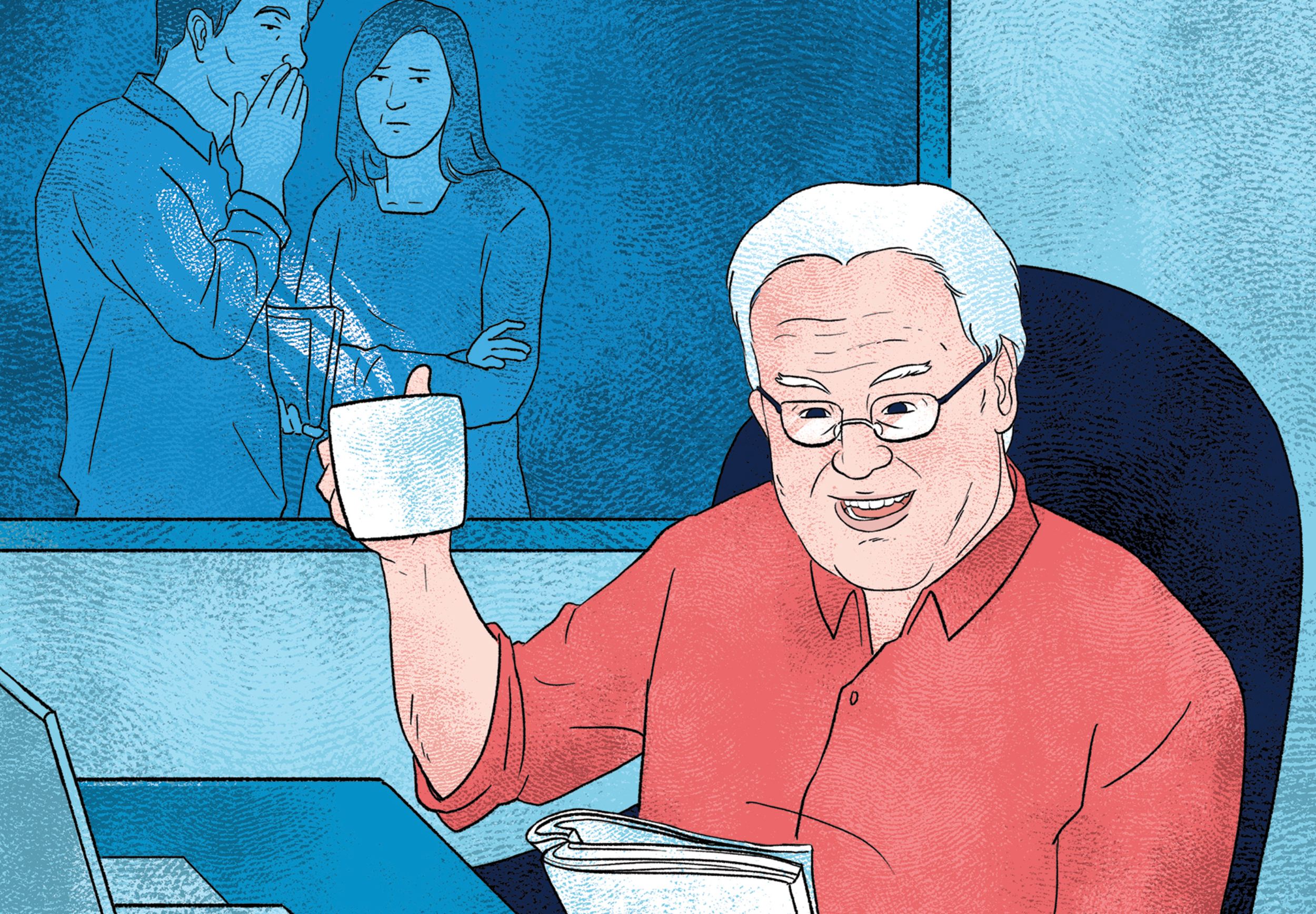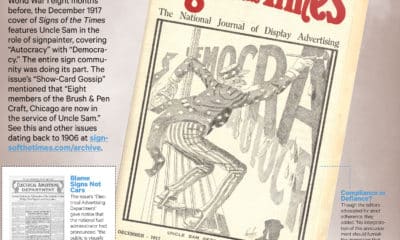
A Sign Company Owner Refuses to Retire
Even fear of AI can’t edge him out in “The Case of the Reluctant Retiree.”
Published
4 months agoon
TIM SMITH, OWNER OF Smithy Designs in Johnson City, TN, opened his just-delivered copy of Signs of the Times’ 2024 Big Survey and immediately turned to the section on retirement plans. Tim had participated in the survey. “Ha!” he exclaimed out loud as he sat at his desk in his otherwise empty office. “I’m not so different!”
He was referring to the set of questions and responses on the age at which the survey takers planned to retire, their exit strategies, the states of their retirement plans and what they’ll do on their first day of retirement. “See,” he said to no one in particular. “About 14% don’t plan to retire.”
ABOUT REAL DEAL
Real Deal scenarios are inspired by true stories, but are changed to sharpen the dilemmas involved and should not be confused with real people or places. Responses are peer-sourced opinions and are NOT a substitute for professional legal advice. Please contact your attorney if you any questions about an employee or customer situation in your own business.
ABOUT THE AUTHOR
Created by ROLF L’MAO, Signs of the Times’ mascot. Email him at editor@signsofthetimes.com.
Illustrations by Karina Marga Cuizon
Neither did Tim, though several external forces were exerting pressure on him to do just that. Not least of all, his family, especially his wife often said to him, “I’ve had it up to ‘here’ with your complaining about work!” His daughter also let Tim know he wasn’t spending enough time with his grandchildren — even on weekends — because he was logging 50 hours per week or more at Smithy Designs.
But it’s not as though he was spending his time at the shop designing signs — as he had at the start of his career — or fabricating them or really almost anything productive. Tim fancied himself as a King Henry V-type manager. “I like to walk amongst my troops and inspire them,” he often said.
Regarding that: “Mostly, it’s a bother,” said Jayla McCreedy, the second in command at Smithy Designs. “Tim thinks he’s pumping people up but most of the time he’s taking them off task.” Over the past few years, some employees even developed a game and system of code words to “hand Tim off” to someone else when having to get something done right away. They even kept score.
Tim had taken his first job in a different sign company 40 years before, and then in 1986, with the publication of Mike Stevens’ landmark text, Mastering Layout, he began training on the ‘old tools’ as a sign designer, just as a design revolution was starting to take place. The Stevens classic closed with a chapter on the future of sign design, stating, “Computers will soon be used to design signs…” Tim had scoffed at that.
Having started his own company a quarter century before, now the designers at Smithy were asking how Tim wanted AI to be integrated into their workflow. AI was something that simultaneously annoyed, unnerved and overwhelmed Tim. He had laughed at his father’s hurried retirement from running an auto parts company at the end of 1999 to avoid the “certain chaos Y2K would bring.” But something about AI was different.
Tim complained to everyone and anyone who would listen that AI would never, ever match the skill and creativity of a human being, but just two weeks before, his lead designer had a laugh showing him two designs for an upcoming project: one hers and one generated by AI. Tim had not been able to discern which was which. Even so, the comparison left Tim unmoved by the role AI might play at Smithy Designs. “Am I the only one who’s seen Terminator?” he sometimes asked.
Jayla and half a dozen other employees had spoken many times about buying Tim out, which seemed the best not only for Smithy Designs but for Tim as well. But each time they broached the subject with him, Tim’s reply remained as predictable as a computer-generated response:
“I’m not going anywhere!”
AdvertisementThe Big Questions
- What would you do if you were String? Try to head off more meetings, nipping this in the bud? Or, ride out the rest of the project, which wouldn’t take forever, to solidify remaining in Clay’s favor? Or something else?
Susan J.
Bainbridge Island, WA
The staff should consider buying Tim out or proposing a plan whereby the employees buy the business in increments, that outlines the evolution of responsibilities from Tim to the employee shareholders.
Steven L.
Spirit Lake, IA
If you have an old boss like Tim at Smithy Designs and are tired of the place, come to me. I have a great sign and design business you can purchase and use AI to advance your career here. I am Steve and ready to step out and retire from Okoboji Graphics.
Patrick H.
Kokomo, IN
Well, I am 70 years old and I think I may have the same type of signshop operation as Tim has. Being frank, I am troubled to read Tim is missing out with the grandkids’ ‘quality time.’ Those times will never come back. They are a gift to cherish and honor. The memories they will hold will be with them when they are gone. I am fascinated with the kids’ memories. They are truly a sponge wanting input. My favorite age is between 7 and 11 years old. They are glowing for information if you can make it a story. Not a lecture. They love it! My suggestion? Read The E-Myth Revisited by Michael E. Gerber. He is “addressing a significant need in the small business market: business owned primarily by people with technical skills but few business skills, and no place to go to get meaningful help.” If I were in Tim’s position, sell it and retire. Enjoy the kids while they still have him. They need his values and love.
Vittorio N.
Italy
This is a tough situation. My father left his business because he was tired of struggling to get reasonable sales margins. After six months, he fell into a sort of depression, but eventually started another business. I believe Tim may follow a similar path, which would create a new problem for his family and the company. Tim is not refusing new resources like AI because he doesn’t understand their potential. He simply feels that he’s not in control since he didn’t build them himself. One solution could be to assign Tim a specific project that is separate from his current business. Alternatively, he could offer his experience to an association. However, if there is a way to make him aware that he’s damaging his own company by refusing to leave space for others to grow, he may be more receptive to change. Tim is quite sensitive about the company he built from scratch, so speaking with an external consultant may be the best way to approach the issue.
Budget Signs
Tim’s retirement should be entirely up to him, but he is working too hard. Someone should suggest that Tim might enjoy more “Tim time” if he cut his hours to four or six a day. He’s earned himself a reward for his years of hard work, and his staff can do without him for a few hours a day. He may find he likes being more part-time, and decide to go full retirement on his own, eventually…
Robert D.
Oakdale, CT
It’s his business to do with whatever he wants. Retire, stay working, either way it has to be Tim’s choosing.
Jim S.
Sunnyvale, TX
I’m in my early 60’s and just started my own sign business after a career in the sign industry in other areas. I plan to work another 10 years then turn the business over to my wife who’s 20 years younger. I can’t afford the Henry V model. That said, it’s his business to stay or leave at his discretion, even if he runs it into the ground in the process. Tim’s team should take some time to talk to Tim about what matters immediately — that he is a distraction in the business. It’s a courageous conversation that needs to be had. Getting the founder of a business to accept they’ll need to step aside is a challenge that should be approached gently and incrementally. As far as technology goes, his team needs to “sell it” rather than “say it.” I wouldn’t hand over my business to managers who didn’t take the initiative to show me how it made sense. Sometimes initiative requires acting and asking for forgiveness rather than permission; just better be right!
Kevin O.
Dallas
Get the family, grandkids included, to force a four-week-long vacation for Tim. Then let the team pursue AI whole-heartedly. In the interim, open the floodgates to AI and with results in hand, invite Tim back (for a day, hopefully) so he can see how the team has integrated AI to the point where it brings in more jobs, decreases design time, decreases overhead costs and makes workflow more fluid. If it starts to replace humans, call Sarah Jeanette Connor ASAP.
Mark R.
San Antonio
To me, retirement is primarily a financial question. If he can financially afford to retire, he should seriously consider a buyout from his employees. One of the toughest things to do from my perspective is sell a business. If he has buyers ready to purchase and it is a fair proposition, he should seriously consider it.
Want to comment on Real Deal scenarios, too? Sign up to receive the stories by email each month before they’re published at signsofthetimes.com/research.
Rolf L'mao is Signs of the Times' mascot. Contact Rolf at editor@signsofthetimes.com

SPONSORED VIDEO
Who’s Steering Signs of the Times?
We dive into the history of the sign industry’s oldest trade journal, highlighting some interesting facts about how it all started to where it’s headed. Did you know that Signs of the Times is nearly 120 years old?
You may like

Canon U.S.A. to Host Webinar on AI Integration in Business

21 Highlights from the American Sign Museum Main Street Expansion

From Chips to Hip
Subscribe

Bulletins
Get the most important news and business ideas from Signs of the Times magazine's news bulletin.
Most Popular
-

 Tip Sheet2 weeks ago
Tip Sheet2 weeks agoSign Tips for Construction Fence Graphics and CNC Tables
-

 Real Deal2 weeks ago
Real Deal2 weeks agoA Wrap Shop Plots to Take Back a Poached Installer
-

 Paula Fargo3 days ago
Paula Fargo3 days agoSelling Your Sign Company Via the Franchising World
-

 Photo Gallery20 hours ago
Photo Gallery20 hours ago21 Highlights from the American Sign Museum Main Street Expansion
-

 Signs of the Times4 days ago
Signs of the Times4 days agoDecember 1917 Signs of the Times Cover: Safe for Democracy
-

 News1 week ago
News1 week agoMUTOH Introduces New Single-Pass ADA Features
-

 Special Report1 week ago
Special Report1 week agoThe Wide World of Non-English Signs
-

 News2 weeks ago
News2 weeks agoWells Fargo Sign Removed From Jacksonville Tower










